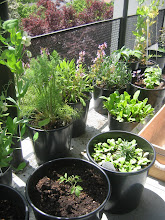I fell in love with this stupid little dog. I don't guess he's any more stupid than any other dog, but you tend to assume that a dog that small has got to be sort of impaired. Just look at the little guy. Weighs a whole 3 pounds. My co-worker Heather brought him over one time this summer when I did some sewing for her, and I thought, well, jeez, he's awfully... adorable. He was perfectly quiet, he just sat around acting like a dog, which is another thing you don't expect from something that tiny. Everything on him wiggles when he moves. Wiggly feet, wiggly ears, wiggly tail. It's awful. Heather tells me he does have some social problems though. Sigh.
You know, people always think there's something inherently screwed up about tiny dogs, and in the sense that their brains are about as big as peas, they're right. There's only so much smarts you can put in a brain that size, but seriously? The truth is that it doesn't take a lot of intelligence to be a dog. Some people tend to deny this, but I suspect that's because they secretly want their dogs to be humans, only less troublesome. Those are the folks who like big oafish things like golden retrievers, or chocolate labs. On the other end of the spectrum are a bunch of people who buy teeny tiny dogs, and then treat them like stuffed animals. Unfortunately, a tiny dog is just as doggy as an enormous one. The difference is that if you bought an energetic large dog, you would think twice about doing any of the incomprehensible and startling (to a dog) things people regularly do to say, chihuahuas. Because if you randomly terrify even a golden retriever, that thing is big enough to bite a piece of you off. Can you imagine swooping in on a sleeping bull terrier, grabbing it, turning it upside down, and making noises like "AAARGGGHHGLGLSNRGLSNRGL!!!!" Of course not. That thing would fuck you up, and you would deserve it. But because a tiny dogs are, well, tiny, their fear and outrage look hilarious to humans, and we do stuff like that to them all the time.
Imagine this: for your whole life, you have been dependent on people for everything it takes to stay alive, from food and water, to a clean place to take a dump, to a safe place to sleep. You can't talk to anybody, because you can't learn the language, and you can't participate in any of the group activities the people you depend on engage in. You are the only person around who is like you. Sometimes you see another similar person at a distance when you are allowed to go outside about once a day, but most of the time you aren't allowed to talk to them.
 Maybe you're Pedro. People do weird things to you. You can't figure out why. Every time somebody gets bored of you, you get passed off to some other set of people. Some of them are mean, some of them are nice, and the worst part is that some of them are alternatingly mean and nice for no apparent reason! Every other live thing you've ever met could kick your ass, and sometimes they do. You're not a bad dog, you're just really nervous, who wouldn't be? So all your conversations start out with you saying something like "Hey, uh, hey, we're cool, right? We're cool? Yeah, I'm cool. Yeah. Yeah. HEY! Like, Respect My Words, right? Or I might bite you! Uhm, but, we're cool, right?"
Maybe you're Pedro. People do weird things to you. You can't figure out why. Every time somebody gets bored of you, you get passed off to some other set of people. Some of them are mean, some of them are nice, and the worst part is that some of them are alternatingly mean and nice for no apparent reason! Every other live thing you've ever met could kick your ass, and sometimes they do. You're not a bad dog, you're just really nervous, who wouldn't be? So all your conversations start out with you saying something like "Hey, uh, hey, we're cool, right? We're cool? Yeah, I'm cool. Yeah. Yeah. HEY! Like, Respect My Words, right? Or I might bite you! Uhm, but, we're cool, right?" Or maybe you luck out, you're one of the retrievers the Petit family kept when I was a kid. The people who take care of you are always kind, they take you on regular interesting field trips, they are consistent in maintaining household discipline, and one of your siblings or children is with you for your whole life. You sorta figure these people out, and even though you can't have a conversation, you really get to like them. You feel like these folks belong to you. Yeah, you spend a lot of time being bored, but on the other hand, you've never once spent a day seriously worried about anything. You tend to meet other people like you pretty regularly on the field trips, and most of the time your conversations start kinda like the one Harriet imagined years and years ago:
Them: Hey! Are you from Dog?
You: No, I was raised in Human, but, like, my parents were Dogs, you know?
Them: Oh wow, I'm totally the same way! I'm a Dog raised in Human too!
You: No way man! That's amazing, who'd'a thought? Well it's nice to meet you!
Poor Pedro was a third-hand dog by the time Heather got him, and she's doing the best she can for the little bugger. I don't want anybody to think I'm against having pets, but I do think that if you get a dog, you ought to think about what it might be like if you were that dog. Would you want to be owned by you? Be honest.


















